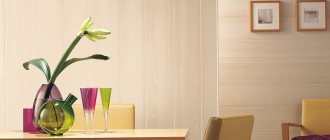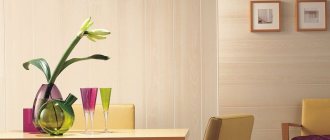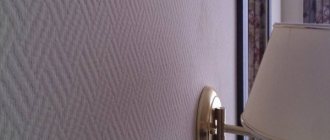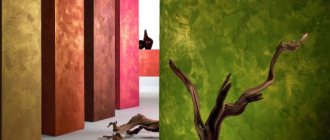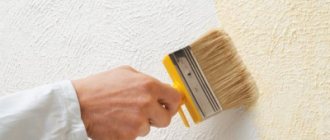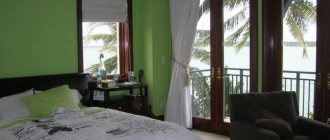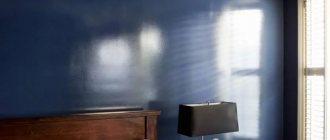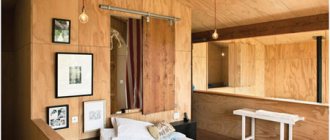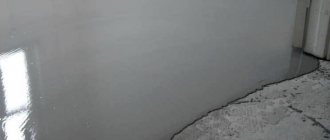Coloring compositions for cork coating
Paints and special compositions for cork surfaces are marked accordingly. Depending on the purpose, protective coatings and decorative ones differ. More information about painting cork floors can be found on the website https://domprobki.com.ua/articles/chem-krasit-probkovoe-pokrytie/.
As a rule, colorless compounds with certain properties (moisture protection, antifungal, insect repellent, fire retardant) are used as protective compounds.
Practical advice
At the first opportunity, before starting to varnish the floor, try the varnish on any section. Before doing this, shake the brushes vigorously several times; this technique will help remove loose bristles from them. Clean the roller as well.
Apply the polish to a small area of the floor first.
Make the first layer with a fairly liquid varnish. Almost all of it will be absorbed into the coating, and existing unevenness will be removed faster. In addition, drying time is significantly reduced, which minimizes the likelihood of dust from the air entering and sticking to surfaces. Immediately after completing the work, all doors and windows must be closed. Let the varnish dry longer, but the risk of clogging it with drafts is eliminated.
Choose the right type of varnish and technology for its application. There are varnishes that can be poured over the surface and leveled using long rules; in other cases, leveling occurs independently. But such technologies require not only professional knowledge, but also an absolutely flat floor surface. Only professionals can carry out construction work of this complexity.
Sometimes the varnish takes a very long time to dry, but there is no need to be upset. There may be several reasons: poor-quality or expired varnish, a damp surface, a violation of the preparation technology. Wait until the crust dries, then you can use fans and heaters, create drafts, etc.
Wait for the top coat of varnish to dry
Never sand the final coat of varnish. If problems are found, they should be eliminated and another layer applied. It is highly advisable to cover the varnished surface with a protective layer. There is a sufficient selection of different types available; select them taking into account the components of the varnish used.
The final coat of varnish cannot be sanded
After some time, the varnish begins to peel off and swell - a big problem. Occurs due to the fact that during varnishing several layers had incompatible solvents. When such a problem occurs, there is only one way out - to completely remove the layers with a sanding machine and begin the process of coating the cork floor with varnish again.
Coating any surface, especially the floor, with varnish is a complex technological process. If you have the slightest doubt about your qualifications, it is better to seek help from professionals. The work will be done not only faster and better, but in many cases much cheaper in the end.
Select types of varnish depending on the load on the flooring. The least traffic is in the bedrooms; here you can use cheaper types. The living room and kitchen require high-quality expensive materials.
And lastly, regarding environmental friendliness. You need to keep in mind that all the furniture in the apartment is covered with the same varnishes. And old furniture contains quite harmful compounds. Do not be afraid that the floor covering will be the last straw; with the correct ventilation modes, the concentration of harmful substances will never exceed the values recommended by regulatory documents.
How to paint?
To use the paint and varnish substance, you will need to prepare the surface of the cork cloth in advance. Preliminary measures include cleaning the surface from dust and dirt, sometimes using a primer mixture for better adhesion.
Cloths made from cork materials have different structures, operating conditions and performance parameters.
To understand. Before painting a cork, you must first decide on the purpose of the surface, and also evaluate the conditions of use.
For wall and decorative paintings, you can use any suitable composition; in the case of floor surfaces, you should choose the appropriate substances.
Applying varnish
You can open the cork with varnish only after the parquet glue has completely dried. Manufacturers of paint and varnish products and parquet specialists tirelessly repeat this, following technical instructions in their work. It is most convenient to apply with a velor roller. It is recommended to treat surfaces in at least three layers.
Typically, paint and varnish products are sold in a ready-to-use solution. Before you start painting, the substance should be thoroughly stirred until uniform. A solution that is too viscous can be diluted slightly. Substances that form the basis of the mixture (water or organic solvents) are used as a diluent, but not more than 10% of the total volume of the package.
For better adhesion, a primer solution for parquet products made from natural materials is additionally used. If the cork profile is not factory impregnated, then feel free to use the selected varnish.
If the decorative coating was previously applied at the factory, a compatibility test of the materials should first be carried out.
It is also recommended to perform intermediate grinding here. This will allow you to obtain a matte, optically more uniform surface. If the finishing layer is applied within 24 hours after the previous layers, then intermediate sanding is not required; more than a day is required. The varnish is applied to a clean, sanded surface, so dust and dirt must be collected with a vacuum cleaner or a dry cloth.
Water-based varnish is good because after using it, working tools and hands can be washed with plain water. But hardened varnish, unfortunately, cannot be removed so easily. Therefore, tools should be put in order immediately after work. If reuse is expected in the near future, then you can wrap the roller in polyethylene or immerse it in a container of water for the time being.
In atmospheric conditions - temperature +20 degrees, air humidity 65% - the varnish will dry within 4 hours. When treating cork with multi-layer varnish, wait a period of at least 24 hours before putting the room into operation. Final polymerization will occur after 5 days. Until this point, it is not recommended to lay carpets and rugs, or to wet clean floors.
Cork surfaces in the interior of premises
Based on the high cost of cork fabric and its unique ornament and texture pattern, it would be pointless to paint this design idea. Therefore, it is worth paying attention to protective and varnish compounds for colorless corks.
Varnishing the cork will only emphasize its grace and originality, make it easier to care for the product and add gloss and elegance.
Coating with fire-resistant protection is important for decorative elements of kitchen premises, or in order to improve fire safety in general.
How to paint cork
Various variations of cork coverings are increasingly used in interior design of residential and commercial premises. This can be a base for laminate or parquet, a full-fledged finishing floor, wall slabs as an alternative to wallpaper and plaster. The main advantage of the material in any of these cases is its naturalness, the absence of polymer impurities, and despite this, excellent performance characteristics. Plus, finished finishing boards or panels have an amazing texture. That is why most owners of such coatings act on the “set it and forget it” principle, enjoying its natural beauty. But, there are situations when, for objective and subjective reasons, it becomes necessary to paint the cork. Let’s try to understand further the controversial aspects of the process, causes and consequences, as well as the necessary materials to carry out this task.
Varnish for cork choice. Which coating is best for cork flooring?
Recently, decorative cork flooring has become widespread, but what kind of varnish to use for cork flooring or cork?
This is an environmentally friendly and natural material that is made from the bark of the cork tree. This material has a huge list of advantages, including strength, durability, practicality, antistatic, easy maintenance, excellent sound and heat insulation characteristics, despite its high cost of approximately 1,200 rubles per 1 sq.m. Despite all its advantages, cork requires a protective layer. Manufacturers took care of this and created special varnishes for cork products.
There are panels that are already produced with treated varnishes, but they are much more expensive. Today we will talk about how to choose the right varnish for cork.
- Characteristics of varnishes
- Kinds
- One-component
- Two-component
- Go to the online store of varnishes and paints for flooring>>
- Polyurethane with solid additives
- Polyurethane with acrylic
- Classification by shades
- Main brands of varnishes for cork coatings
- How to varnish cork flooring
- Stage 1. Preparatory
- Stage 2. Application
- Stage 3. Grinding
- Caring for varnished cork flooring
- Conclusion
What do you have to deal with?
The use of any paint, regardless of type, has two main goals:
Decorative. Changing the color, shade of the surface to suit certain design ideas or create a more attractive appearance;
Protective. Creation of a barrier film on the surface that prevents contact of the main layer of material with external aggressive irritants.
In turn, the treated surfaces have different characteristics, structure, and operating conditions. This definitely affects the selection of paints, since what is suitable for metal is absolutely not suitable for wood. First of all, you need to understand how the cork works, what properties it differs in and how it behaves.
So, any of the available cork coverings (underlayment, floor/wall panels, interlocking floors) basically contains agglomerate. Simply put, it is the bark of the oak tree of the same name, crushed to a fraction of crumbs, which is mixed with natural binding components (resins) and pressed into slabs of different thicknesses. If you examine the finished product under a microscope, you can see the following picture.
Cork in the interior: decorating walls and floors
Cork is a finishing material unique in its qualities. Cork walls and floors, in addition to their decorative qualities, are able to absorb sounds, retain heat and, imagine, do not collect dust!
- 1 of 1
On the picture:
Cork furniture.
Sometimes cork is used as a material for the production of decorative panels and designer furniture (stools, low tables). It is clear that we are not talking about serial products. Cork is used to make furniture art objects for connoisseurs of modern design.
In the photo: Cork Chair model from the Vitra factory, designed by Morrison Jasper.
Advantages of cork
Cork (cork oak bark) has many advantages over other finishing materials:
- It is resistant to burning, rotting and the action of solvents (due to the wax, lignin, complex of fats, acids and organic alcohols included in its composition).
- It does not accumulate static electricity, and therefore the surfaces lined with it are not “dust collectors”.
- It has high sound and heat insulating qualities. Soundproofing cork underlay is used for laying under parquet, laminate or wall panels.
- It is lightweight, so the cork-trimmed structure is never loaded.
- Able to restore shape and volume after deformation due to its structure (waterproof cells filled with air).
- It has high elasticity, because is a natural polymer.
- Eco-friendly, as it is a natural material.
- Beautiful. There are decorative cork coverings for walls and floors.
Floor: 2 types of installation
- Adhesive floor. Cork flooring is attached to the base floor using adhesive. Tiles of different sizes can be combined. Essentially, these are sandwich panels 3.2-4 cm thick: the base is pressed cork, and on top there is a decorative cork veneer, usually covered with a protective layer of varnish, wax or vinyl.
Examples of floating and adhesive cork flooring.
Pictured: floating cork floor.
Cork colors
– predominantly natural: ocher, brown and gray shades. Sometimes cork coverings are tinted with pastel colors and bright splashes are added to them. The texture of the material can also be varied: granular, lamellar, with marble-like stains, etc.
In the photo: model 370700 from the Eijffinger factory.
- "Floating" floor. Boards with a decorative cork coating are fixed using click fasteners and pressed against the baseboards. Or they are connected to each other using a tongue-and-groove system with the seams glued with a special compound. Cork flooring can also be laid on top of the old one (on laminate or linoleum), if it is smooth and strong.
Walls
Construction + finishing at the same time. Cork is used primarily for insulation and sound insulation. Cork wall coverings come in the form of panels or wallpaper. The wall panel consists of a base of cork chips and cork veneer, and cork wallpaper is made of compressed cork chips glued to paper or non-woven fabric. A cork covering for walls with a thickness of only 3 cm can be compared in terms of thermal insulation quality with a 40 cm brick wall.
Different views on the issue
Anyone who, despite the relatively high cost of cork, still decides to use it for interior decoration, does so based on environmental friendliness, performance characteristics and the unique natural pattern of the material. It is this social and design traditionalism that largely determines the fact that it is not customary to paint such coatings. The maximum (and necessary) is a protective varnish treatment that emphasizes the texture.
In order to understand all the conservatism, just look at any specialized thematic forum and “Is it possible to paint cork?” In general, the entire subsequent information message will be reduced to the following formulation: “Why do this at all, how can you think of such a thing, because the paint hides the natural texture, which is why you bought the cork.”
This situation arises because this audience, for the most part, has not tried to paint such a coating. But this does not objectively mean that it is impossible or impossible to do this. Moreover, there are several objective reasons when painting is unavoidable or justified:
The color or shade of the cork does not match the desired color scheme of the room;
There is a desire to decorate certain areas of the floor or wall panels, for example, with a pattern;
The presence of defects from use on the surface, which cannot be eliminated by replacing the damaged section of the masonry without the ability, skills or desire.
Cork floor coverings
Special varnishes for cork floors are highly elastic and do not form cracks when the material deforms during use.
And, by the way, floating floors are varnished during production. And adhesive tiles can be either varnished or simply sanded. Such a floor must be covered with at least three layers of varnish. There are special polishes on sale that will restore the shine and brightness of colors to cork floors after several years of use.
A common misconception is that cork parquet is viewed as a very delicate material and, therefore, unable to withstand high loads. In fact, in terms of strength and wear resistance, cork flooring is not inferior to traditional wooden ones, and, taking into account the special properties of the branded polyurethane varnish, they are superior to it. With proper installation, the service life of cork coverings exceeds 50 years.
There is no particular reason to refuse a cork ceiling. If desired, it can be tinted (painted) in any color. Moreover, as we have already noted, water dripping from neighbors above will not cause harm to such a ceiling.
Materials made from natural cork will decorate your interior and give it elegance, making it unique and attractive, and the guest will not be slow to note the refined taste of the owners.
Materials provided by Cork Interior salon
Buy cork coverings in Nizhny Novgorod
How and with what to paint?
Since there are virtually no restrictions for painting cork, except mental ones, you can safely get to work. The first step is to choose the right main consumables. Obviously, from the entire list of paint and varnish mixtures available on the market, you need to focus on those that are created for processing wood. These can be either water-dispersed or water-based paints, or acrylic paints. As in the case of cork, you should not skimp on them, since this will ultimately affect the mechanical integrity and visual and decorative qualities of the coating.
Alternatively, you can use various stains, impregnations and oils. A common feature of all these materials is the ability to penetrate into the pores of the cork, creating a reliable protective barrier. At the same time, the coating does not at all interfere with air circulation inside the slabs, which means that the risk of rotting or the development of pathogenic microflora is eliminated. In addition, such impregnations tend to expand with temperature changes along with the wood, which will allow it to maintain its appearance for up to 8-12 years.
There is also a separate group of oils with various additives, for example, hard wax. The uniqueness of this group of paint and varnish products lies in the fact that the cork treated with them acquires additional strength, wear resistance, and water-repellent properties. These materials are also made on the basis of natural ingredients (linseed, sunflower, soybean and other oils), that is, they are environmentally friendly and safe. If you add a suitable pigment paste to the mixture during the dyeing process, you can radically change the shade or even color.
It is better to entrust all work to specialists, although, if you have certain skills, this task will not cause any particular difficulties. Naturally, you will first have to completely clean the surface of the cork coating from the base layers of varnish, thoroughly polish it and clean it from dust. Next, in accordance with the manufacturer’s recommendations, 2-3 layers of paint, stain, and oil are applied. Each subsequent layer is applied only after the previous one has dried. The final stage will require treatment with clear varnish. If oils were used, then after they dry, it will be enough to simply polish the cork.
Cork wall covering: 10 answers to pressing questions
What are cork wall coverings made of?
Cork oak bark is used as raw material. The largest plantations of these trees are in Portugal. The bark is removed once every 9-10 years, and then it grows back. At the same time, the tree continues to live without suffering.
The base of the cork wall panel consists of agglomerated cork, i.e. compressed cork chips. Cork veneer is glued on top of the base, which gives each panel a unique design. The final coating is often wax, less often a special varnish.
Wall plug is a completely natural material that does not contain synthetic resins or other artificial additives. The material is absolutely safe, hypoallergenic, environmentally friendly. Even when heated, toxic substances will not be released from it.
In what size are the panels made?
Cork panels for walls most often have a thickness of 3 mm and overall dimensions of 600x300 mm. But some manufacturers also produce non-standard slabs, for example, 900x300 mm. This format allows for easy installation of the coating. At the same time, the seams between the panels are not noticeable; they can only be detected upon closer inspection.
Will cork stand the test of fire and water?
Think bottle caps. Bottled wine can be stored for decades. There are known cases when wine was found on sunken ships that had lain in the water for a hundred years - the cork and wine were in excellent condition. Also, a wall-mounted cork can easily withstand wet cleaning, changes in indoor humidity, and even flooding from neighbors.
When exposed to flame, the cork lights up with a small flame and slowly smolders, however, if the source of open flame disappears, the cork goes out.
Do cork panels soundproof a room?
Cork has a cellular structure; the smallest cells are filled with air, therefore reducing impact noise. Of course, 3 mm thick panels cannot completely remove sounds from a neighboring room, but they reduce the noise level and eliminate echoes, creating excellent acoustics. The degree of sound insulation directly depends on the thickness of the material. And to increase its degree, technical cork and cork agglomerate with greater thickness are used.
Do cork walls provide thermal insulation?
The same structure with millions of pores gives cork low thermal conductivity, which is why technical cork is considered the best heat insulator.
Thermal conductivity of cork wall panels 0.042 W/m*deg
(Thermal conductivity data at room temperature)
It is also calculated that 15 cm of agglomerated cork replaces a 1 m thick brick wall in terms of thermal insulation properties.
What does this give to the room? Even outdoor cork walls in an apartment or private house will be warm in winter; in rooms with such decoration it will be better to maintain the temperature regime, both when it gets cold and when it gets hot.
What designs are available in cork wall panels?
There is a widespread belief that cork coatings only have shades in the brown range. Indeed, classic cork is represented in such shades. However, the range of modern cork wall panels makes it clear that cork walls come in many different forms.
Cork panels are painted in a variety of colors - from pastel to bright and dark, and photo printing is applied, thanks to which the wall cork depicts stone, decorative brick, and leather. Original 3D panels are created from cork, with the help of their three-dimensional texture you can effectively zone a room.
With the help of such extraordinary cork panels you can transform any interior - both classic and modern. For light walls, for example, Wicanders Brick panels in Sand or White decors would be an excellent solution.
For modern interiors with dark walls, a worthy option would be cork with a texture similar to elegant bricks or cork painted in dark colors. Contrary to beliefs, the loft style can also be pleasant to the touch and contain natural materials.
Cork: how to paint it
In the field of interior design, much attention is paid to natural and environmentally friendly materials.
Natural cork, which is widely used for cladding walls and floors, can also emphasize natural motifs. This material is unique in its strength, durability, practicality, and is easy to care for. Cork is a good antistatic agent, and it also has heat and sound insulation properties. In order for the decorative coating to last longer, it is necessary to use a special varnish. In order for a decorative coating, especially a floor covering, to last longer, it is necessary to protect it.
How to properly glue cork wallpaper
The technology for gluing cork wallpaper is very similar to gluing walls with regular wallpaper, with the exception of some nuances. The surface of the walls must be smooth, otherwise all irregularities will be clearly visible on the surface of the wallpaper. Therefore, before gluing, you need to level the walls with putty and finishing plaster. Before starting work, it is better to unroll the wallpaper roll and let it straighten, since such wallpaper is subject to deformation, but after a while it returns to its original shape. It is better to choose a special glue, but you can glue it to acrylic, pressing the wallpaper firmly against the wall.
How to paint cork floors
Cork is durable. It is clear that over time the owners will want to renovate the house, but for this it is not necessary to dismantle the cork floor if it does not fit into the overall style of the interior design. It can be painted, varnished, and its performance properties can be improved by using special impregnation compounds.
If you are thinking about the question of how to paint cork, the answer can be found on specialized websites. It is worth noting that painting cork is quite difficult. If you simply apply paint over the coating, you can only cause harm, since the paint will not last long and will also clog the pores, causing the floor to lose its properties.
The best option would be complex processing of the material:
- thorough cleaning of the slabs from the original layers of varnish and paint;
- grinding;
- dust removal;
- applying primer, paint, stain in several layers;
- At the last stage, a transparent varnish is applied.
To lighten the coating a little, if you are generally satisfied with the color, you can simply use transparent emulsion paints or colorless varnish. They also use the method of applying natural oil, to which a paste with the desired pigment is added. If you adhere to the technology, then after painting the coating will look like new. Experts also recommend not starting work on your own if you are not sure of the end result.
Cork floor care
Cork does not tolerate both high and low humidity. In winter, it is advisable to use humidifiers in the room. If you accidentally spill liquid, wipe it up immediately. You can wash the floor using detergents without aggressive ingredients. In this case, the rag should not be too wet, but only slightly damp.
Make sure that there are soft felt pads on the legs of the furniture, otherwise the cork will begin to fall around the legs. Applying polyurethane-based varnish is also an important maintenance step. From time to time the floor needs to be sanded and re-varnished. You can find special cork care products on sale. They need to be evenly distributed over the floor surface and wait until completely dry.
Cork for wall decoration: advantages and disadvantages, types of cork coverings
Cork has been used as a finishing material for several hundred years. However, it was in the decoration of walls and ceilings that this material began to be used relatively recently. Thanks to modern technologies, cork has become not only practical, but also acquired remarkable decorative characteristics. Today, on the finishing materials market, some types of cork are leaders among other options, since at a relatively low cost they are of high quality, easy to maintain and have a long service life.
Cork is an organic material that is ideal for interior decoration. It is made from crushed, pre-treated bark of certain varieties of Mediterranean oak. Thanks to modern technologies, after application the coating has a porous structure, allowing the walls to “breathe”, but at the same time gives a soundproofing effect and retains heat longer.
Advantages and disadvantages of cork covering
To evaluate cork flooring, it is important to know its advantages and disadvantages. This material, although popular, has its pros and cons, like other types of finishes. Let's look at the list of advantages:
• relatively low cost of material;
• service life is about 7-10 years, depending on the variety;
• the material is absolutely safe and non-toxic;
• cork coating is easy to apply;
• masks surface defects on which it is applied;
• decorativeness allows you to implement any design solutions in various styles;
• resistance to corrosion and mold;
• cork flooring is easy to care for.
These are not all the benefits of cork. In order to fully appreciate the quality, decorativeness and performance characteristics, it is necessary to consider each type of cork covering separately. But, it is important to remember about the disadvantages - for all its qualities, the coating remains sensitive to severe mechanical damage, and is also not suitable for all types of premises.
Types of cork coverings for wall decoration
When choosing a cork covering for wall decoration, it is important to determine its intended purpose and, based on this, select the appropriate option. The modern market of finishing materials offers various types of coatings that differ in quality, method of application, decorative properties and performance characteristics. To navigate the assortment of hardware stores, you need to know general information about each variety. This will help you choose the best option. Let's look at the existing types of cork flooring.
Liquid plug
As a rule, liquid cork finishing is used to decorate the surface of walls outside. It is popular to use liquid cork finishing for the walls of country houses, cottages, and dachas. Liquid cork coating consists of 96% natural wood, crushed using a special technology into fine crumbs, due to which a porous structure is achieved. The rest is a special acrylic binder that ensures the strength and durability of the coating.
The technology for applying finishing to walls is spraying with a spray bottle. Liquid cork is moisture resistant, easy to apply and allows you to hide any imperfections on the walls. Liquid cork can also be successfully used for interior decoration. After application and drying, the layer can reach 3-4 mm, which provides a high degree of thermal insulation.
Cork rolls
Cork rolls are used for interior and exterior decoration, to create patterns and design accents. Roll coating goes well with other materials in the interior, and after application it can be painted, waxed or varnished, thereby expanding design possibilities.
When installed correctly, the cork roll covering does not contain joints or seams and is a smooth, uniform surface. The thickness of the cork sheet in a roll is from 1 to 2 mm. It is easy to apply rolled cork finishing - no specialized surface preparation is required, since the canvas is firmly glued to high-quality acrylic glue and hides defects and unevenness of the walls. Cork rolls should not be confused with cork wallpaper - these are different types of finishing materials.
Cork wallpaper
The most inexpensive and easiest to use material is cork wallpaper. They are relatively thinner than roll finishes and are distinguished by the presence of a synthetic or paper base, onto which a thin layer of wood chips and varnish is applied. Cork wallpaper is made in various designs and colors and may contain decorative patterns. The operational and decorative characteristics are the same as those of other types of coating. The only drawback is the relatively short service life.
Cork boards
Cork modules are two-layer panels consisting of crushed wood and natural adhesive components. Their thickness can exceed 2 mm, due to which the panels most effectively perform heat-insulating and sound-proofing functions. Installation of cork panels is done by gluing them to the surface of the walls. Standard panel sizes are 60x30 cm or 30x30 cm.
How to care for cork trim?
After completing the finishing work, it is recommended to treat the surface with special wax, or use acrylic varnish. As a rule, water-based varnish is used, so the coating remains environmentally friendly. After applying protective wax or varnish and drying it, the coating is ready for use. The coating can be washed and wiped, but for this it is advisable to use specialized chemicals. Another important rule of care is that it is better to protect cork from sunlight, as it reduces its service life and can spoil the decorative properties of the finish.
Cork floor painting options
The top layer of cork is made from solid cork veneer.
It can also be pressed cork chips or a combination of veneer and agglomerate. In any variation, cork flooring looks impressive and beautiful. Designers offer interesting options for how to paint cork to make it sparkle with new interesting colors. As a rule, the cork is simply varnished, then it retains its appearance and texture, but becomes more durable.
If you paint the cork with paint, the material will be unrecognizable. So is it possible to paint cork, and in what situations should it be done?
Choosing cork wallpaper for rooms
Cork wallpaper for walls, the design of which looks great both in the hallway and in the corridor. In addition, these wallpapers are easy to wash, and therefore they will always look like new, and you will not ask the question: how to glue cork wallpaper, because they are glued in exactly the same way as the simplest paper ones. Not long ago a new product came out where the wallpaper already has a paper-based adhesive composition, and gluing it is a pleasure. Cork wallpaper is very beautiful and always pleasing to the eye; if it is in the hallway, it will certainly delight guests. The hallway or hall, as it were, forms the first impression of the entire house as a whole, and therefore this wallpaper is perfect for such a room. Cork wallpaper will resemble a forest and therefore the interior can be supplemented with details such as the likeness of an old tree or thematic paintings.
Cork wallpaper for walls would also be a good choice for the kitchen, as they not only look beautiful, but also have excellent characteristics, not absorbing odors, fats and oils. If stains appear on the walls, they can be washed off: fresh stains with just warm water, and those that have already hardened with a cleaning agent. Manufacturers usually list cleaning products on the packaging.
Walls decorated with cork wallpaper in the bathroom will look interesting and original; this material can replace “cold tiles” and tiles. At the same time, the wallpaper is resistant to fungi and mold, which can appear in a room with high humidity.
And, of course, a design with cork wallpaper for the walls will look great in the living room. They will help create an atmosphere of comfort and warmth, and make the interior unique. An added bonus when using cork wallpaper in the living room is that it improves the acoustics in the room, making the living room a great home theater. In addition, such wallpaper is suitable for zoning a room, if you make one zone for relaxation and another for receiving guests.
For children's wallpaper, cork wallpaper can be chosen only because of one parameter: safety. They do not cause allergies, do not emit any harmful substances and do not support combustion. And with the help of a designer, the nursery can be made original in the “nature, forest” style, and your child will definitely love his room.
Cork wallpaper sticker
If the price of cork wallpaper for walls does not bother you (from 400 rubles to 3000 rubles per sq.m.), then the ideal option would be to make the entire house or apartment in the same style. At the same time, you can make interesting applications, paintings and patterns from such wallpaper, and by covering them with varnish, they will look even brighter and last much longer. In most cases, such wallpapers are sold in natural colors and with natural patterns. But since such wallpapers are more suitable for classics, manufacturers began to produce options with colored splashes; the price for cork wallpaper for walls is slightly higher than for ordinary ones. However, a variety of such wallpapers will allow you to implement modern design solutions.
Most often, manufacturers produce rolls of cork wallpaper for walls, measuring 5500x760 mm. This is the most convenient and optimal option, which is suitable for all types of surfaces: wood, plaster, concrete or glass. After the purchase, everyone who decides to do the repairs themselves asks themselves the question: how to glue cork wallpaper?
But this is not difficult to do. It is worth additionally purchasing a special glue for heavy wallpaper, applying it evenly to the wall, and gluing the wallpaper, joining the seams so that the edges are not noticeable. There is a debate among experts about what is better to apply glue to, and since some say that a wall would be better, while others say wallpaper, the choice will be yours. If you do apply glue to the wall, you should stock up on a spatula and a comb to apply and level the layer. Apply glue only where the cork wallpaper for the walls will be glued at the moment, otherwise the glue will dry out and you will have to clean the surface again.
Types of cork floors
Before deciding whether to paint the floor from the material described or leave it as it is, natural and natural, you need to understand the main types of coating.
Cork floors are:
- Floating floors. The material is a short board up to 13 mm thick, consisting of several layers. Usually this is four layers and this coating is laid according to the principle of parquet. If you put it in the kitchen, you need to cover it with several layers of protective varnish so that moisture does not spoil the floor over time.
- Adhesive floors are no more than 6 mm thick. If you find an adhesive plug that is less thick, this means that it is intended for walls and is not suitable for floors. The types of tiles in such a situation may be different. The advantage of this type of cork is that it is not afraid of moisture. These floors take longer to install and are more expensive than floating floors in total cost.
Cork wallpaper in the interior (43 photos): nature in your home
Content
- Cork wallpaper: assessing the benefits
- Choosing cork wallpaper
- How to properly glue cork wallpaper
- Cork wallpaper in the interior - video, photo
Cork is the common everyday name for the bark of the cork oak (family - beech, an evergreen plant with a trunk thickness of up to 1 m, height - up to 20 m). The peculiarity of this tree is its quickly regenerating (restoring) bark. They begin to obtain bark from 15-20-year-old trees, removing it from the trunk once every 10 years - the procedure itself is absolutely safe for the tree, which retains its properties for up to 200 years. The most famous producer is Portugal, which accounts for more than a third of the cork produced worldwide. Less known are producers from Spain, Italy, France, and North Africa.
Cork will be the highlight of any interior
Is it possible to paint cork flooring?
Among builders and designers, the question of whether cork can be painted is always the cornerstone. The main reason for the conflict is why paint a beautiful and natural natural material.
Builders believe that there is no need to paint cork with any paints; they just need to cover the floor with several layers of varnish to improve performance.
The designers claim that if the owners want it, they can safely paint the cork. Sometimes there are situations when the natural color of cork is simply not suitable for creating a unique and ideal room concept. In such a situation, you cannot do without painting the cork.
Read here how to prevent scratches on your floor.
Otherwise, the design project will be impossible to implement. But it is not recommended to paint cork yourself, because this material is very delicate. It is important to choose the right color palette so that painting is justified in the end.
Since fading often occurs over more than one year, people simply do not notice the faded areas. But when rearranging furniture, this area may become noticeable. In such a situation, painting is needed to level the surface and again obtain an ideal coating.
If you couldn’t even it out to a natural color, you can think about a completely different palette, atypical for cork.
DIY wall decoration from cork material
If you decide to glue cork to the wall, you first need to prepare the wall. And also prepare the cork covering, buy glue and tools.
Surface preparation: essential features
You need to clean off dust and dirt from the walls, level them, and apply a primer. The primer strengthens the base and prevents the formation of bacteria. Afterwards you should wait for the primer to dry completely. For leveling, you cannot use gypsum-based compounds, as they can ruin the finishing material. When working, you need to remember that the air humidity level should not be higher than 65%, and the air temperature should be 18°. Wall humidity up to 3%.
Fastening sheets with a screwdriver
It is best to attach cork panels with a screwdriver. In this case, special clamps or brackets are used.
How to glue wallpaper
Materials and tools:
- Old fabric.
- Pencil or marker.
- Construction plumb.
- Scissors and a knife designed for cutting drywall.
- Small spatula.
- Comb for applying glue.
- Wooden or metal ruler.
The base must be completely dry, since the glue does not stick the material to a wet wall. The work must be done when the air humidity in the room is 40-60%, because wallpaper cannot withstand too dry air.
- You can check the humidity with a hygrometer. Next, measure the walls.
- Use a building level and a pencil to mark a vertical line on the wall.
- Mark the wallpaper and cut it to the required length with a very sharp construction knife, since the cork material is very brittle.
- If acrylic glue is applied to the wallpaper with a plastic spatula, then the wallpaper must be glued immediately. If it is contact glue, then first soak the wallpaper with glue for 5-10 minutes, and then glue it.
- Since glue cannot be removed from the front side of the wallpaper, do not allow it to get there.
- Cork wallpaper is glued horizontally or vertically.
- Various cutouts, for example, for sockets, should be made according to a template, that is, according to the socket box.
- In corners, cork wallpaper is not folded; it is applied to the corner, joined and cut off. If the cork wallpaper is already covered with wax, but dirty marks are visible on it, then you need to warm up this place with a hairdryer, then the wax will become soft and the marks will disappear.
How to paint cork
How to paint cork and how best to do it should be decided only with a professional. Painting cork yourself will be difficult, because such processing is unnatural for this material.
Painting adhesive floors will be much easier than floating flooring options. They need to be sanded before painting, but do not need to be varnished. When you want to preserve the pleasant natural structure of the natural material being described, it is better to choose a transparent natural color.
Cork floor repair: how to fix scratches, chips and worn out areas
When exposed to sharp objects, scratches and chips may occur on the cork floor, and abrasions may appear from the wheels of the chairs over time. However, with such minor damage to the cork veneer, it is not necessary to change the floor elements. You can try to restore the dies.
Weathered veneer
If the floors have a surface made of natural or tinted cork veneer, then you need to buy a wood sealant that is similar in color to the floor. You can also use a plastic and MDF restoration product.
Apply the product to the damaged areas in a thin layer and wait to dry.
Then they sand, leveling the surface and making it smooth.
Carefully remove crumbs and dust.
Covered with wear-resistant varnish. It is advisable to use a completely glued floor; a castle floor has only separate tiles.
View of the floor after restoration
If you have a cork floor with photo printing, then it is unlikely that you will be able to hide the damage, because... For such coatings, it is necessary to restore not only the shade, but also the texture (pattern of wood, stone, etc.).
Cork finishing has many advantages:
- Cork is a natural material. Dust does not accumulate on it, it smells pleasant, is antistatic and reduces the level of various radiations.
- Wallpaper and tiles are very light.
- Cork is elastic and resilient. If you squeeze it, it will return to its original shape.
- It does not allow moisture and gases to pass through due to the presence of suberin. Suberin is a substance found in the bark of cork trees. Because of this, it does not rot or become moldy.
- The coating does not conduct heat and vibration well due to gas elements.
- The coating is very durable and wear-resistant.
- The material is hypoallergenic, does not harm health, does not absorb fat, oil and acetone.
- Does not allow sounds to pass through.
- It has thermal insulation properties and reduces heat loss. But even a very thick layer of cork cannot replace polystyrene foam of the same thickness.
- The cork is easy to install and easy to care for.
The main disadvantage of cork material is its expensive price.
